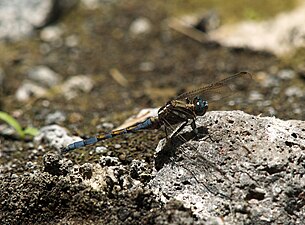Orthetrum chrysostigma
- Machine translation, like DeepL or Google Translate, is a useful starting point for translations, but translators must revise errors as necessary and confirm that the translation is accurate, rather than simply copy-pasting machine-translated text into the English Wikipedia.
- Do not translate text that appears unreliable or low-quality. If possible, verify the text with references provided in the foreign-language article.
- You must provide copyright attribution in the edit summary accompanying your translation by providing an interlanguage link to the source of your translation. A model attribution edit summary is
Content in this edit is translated from the existing German Wikipedia article at [[:de:Rahmstreif-Blaupfeil]]; see its history for attribution. - You may also add the template
{{Translated|de|Rahmstreif-Blaupfeil}}to the talk page. - For more guidance, see Wikipedia:Translation.
| Orthetrum chrysostigma | |
|---|---|
 | |
| Male | |
 | |
| Female | |
Conservation status | |
 Least Concern (IUCN 3.1)[1] | |
| Scientific classification | |
| Domain: | Eukaryota |
| Kingdom: | Animalia |
| Phylum: | Arthropoda |
| Class: | Insecta |
| Order: | Odonata |
| Infraorder: | Anisoptera |
| Family: | Libellulidae |
| Genus: | Orthetrum |
| Species: | O. chrysostigma |
| Binomial name | |
| Orthetrum chrysostigma (Burmeister, 1839) | |
Orthetrum chrysostigma, the epaulet skimmer, is a species of dragonfly in the family Libellulidae. It is found in Algeria, Angola, Benin, Botswana, Burkina Faso, Cameroon, Central African Republic, Chad, the Democratic Republic of the Congo, Ivory Coast, Egypt, Equatorial Guinea, Ethiopia, Gambia, Ghana, Guinea, Kenya, Liberia, Libya, Malawi, Mali, Mauritania, Morocco, Mozambique, Namibia, Niger, Nigeria, Senegal, Sierra Leone, Somalia, South Africa, Sudan, Tanzania, Togo, Uganda, Zambia, Zimbabwe, and possibly Burundi as well as Canary Islands, Israel, and Portugal. It was recorded in the Maltese Islands in 2010. One was also spotted in Tel Aviv, Israel in August 2022.
Its natural habitats are subtropical or tropical moist lowland forests, dry savanna, moist savanna, subtropical or tropical dry shrubland, subtropical or tropical moist shrubland, rivers, intermittent rivers, shrub-dominated wetlands, swamps, freshwater lakes, intermittent freshwater lakes, freshwater marshes, intermittent freshwater marshes, and freshwater springs. The adults prey on various flying insects. The bodies of adult males are blue, and those of young and females are yellow and brown.
-
 Immature male
Immature male -
 Young adult male
Young adult male
References
- ^ Boudot, J.-P.; Clausnitzer, V.; Samraoui, B.; Suhling, F.; Dijkstra, K.-D.B.; Schneider, W. (2016). "Orthetrum chrysostigma". IUCN Red List of Threatened Species. 2016: e.T59954A83856823. doi:10.2305/IUCN.UK.2016-3.RLTS.T59954A83856823.en. Retrieved 16 November 2021.
- GAUCI, C. & SCIBERRAS, A. (2010) First Records of Orthetrum chrysostigma (Odonata:Libellulidae) Burmeister, 1839 in the Maltese Islands. Central Mediterranean Naturalist 5(2):78-80. Nature Trust Malta publications.
External links
 Media related to Orthetrum chrysostigma at Wikimedia Commons
Media related to Orthetrum chrysostigma at Wikimedia Commons Data related to Orthetrum chrysostigma at Wikispecies
Data related to Orthetrum chrysostigma at Wikispecies- Orthetrum chrysostigma on African Dragonflies and Damselflies Online
- v
- t
- e















